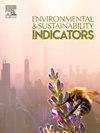The differentiated impacts of interprovincial trade on achieving nine environment-related SDGs in China
IF 5.4
Q1 ENVIRONMENTAL SCIENCES
引用次数: 0
Abstract
In the wave of globalization, trade has had profound and unique impacts on resource allocation and the Sustainable Development Goals (SDGs) among different regions. However, we still have a limited understanding of the impacts of interprovincial trade on environment-related SDGs, especially compared with the counterfactual no-trade scenario. Therefore, via an environmentally extended multiregional input‒output model and scenario analysis, we explored the impacts of interprovincial trade on the achievement of nine environmental-related SDG targets across 31 provinces in China. The results revealed that interprovincial trade has improved environmental sustainability across the country, with the total score of the nine SDGs increasing by 4.3%. Specifically, trade positively contributed to the achievement of SDG6.4 (sustainable water use) and SDG9.4 (clean industrialization) in eight sectors and slightly inhibited the achievement of SDG7.3 (primary energy efficiency). In addition, interprovincial trade has exerted greater environmental pressure on developing provinces (e.g., Nei Mongol, Jilin and Heilongjiang) with better natural resource endowments than developed provinces (e.g., Beijing, Tianjin, Shanghai). Importantly, we found that the impacts on the total SDG score was significantly associated with GDP per capita (R = 0.65, p < 0.01). Therefore, regions and sectors that are vulnerable to negative impacts need increasing technical and policy support.
省际贸易对中国实现9个环境相关可持续发展目标的差异化影响
在全球化浪潮中,贸易对不同地区的资源分配和可持续发展目标(SDGs)产生了深刻而独特的影响。然而,我们对省际贸易对环境相关可持续发展目标的影响的了解仍然有限,尤其是与反事实的无贸易情景相比。因此,我们通过环境扩展的多区域投入产出模型和情景分析,探讨了省际贸易对中国 31 个省份实现九项与环境相关的可持续发展目标的影响。结果显示,省际贸易改善了全国的环境可持续性,九项可持续发展目标的总分提高了 4.3%。具体而言,贸易积极促进了八个部门实现可持续发展目标 6.4(水资源可持续利用)和可持续发展目标 9.4(清洁工业化),但略微抑制了可持续发展目标 7.3(一次能源效率)的实现。此外,与发达省份(如北京、天津、上海)相比,省际贸易对自然资源禀赋较好的发展中省份(如内蒙古、吉林和黑龙江)造成了更大的环境压力。重要的是,我们发现对可持续发展目标总分的影响与人均 GDP 显著相关(R = 0.65,p <0.01)。因此,易受负面影响的地区和部门需要更多的技术和政策支持。
本文章由计算机程序翻译,如有差异,请以英文原文为准。
求助全文
约1分钟内获得全文
求助全文
来源期刊

Environmental and Sustainability Indicators
Environmental Science-Environmental Science (miscellaneous)
CiteScore
7.80
自引率
2.30%
发文量
49
审稿时长
57 days
 求助内容:
求助内容: 应助结果提醒方式:
应助结果提醒方式:


